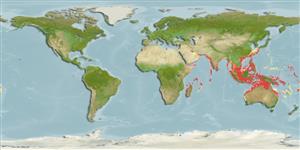Environment: milieu / climate zone / depth range / distribution range
ນິເວດວິທະຍາ
ສັດທະເລ; ນ້ຳກ່ອຍ ກ່ຽວກັນຫີນ; ລະດັບຄວາມເລິກ 12 - 100 m (Ref. 55). Tropical; 33°N - 33°S, 43°E - 178°W
Indo-West Pacific: Persian Gulf and Arabian Sea to Fiji, north to southern Japan, south to Australia. This species has been frequently misidentified as Lutjanus sanguineus (Ref. 55). There are unsubstantiated reports of this species from off East Africa.
Length at first maturity / ຂະໜາດ / ນ້ຳໜັກ / Age
Maturity: Lm 57.6, range 54 - ? cm
Max length : 100.0 cm TL ຕົວຜູ້/ບໍ່ມີເພດ; (Ref. 55); common length : 50.0 cm TL ຕົວຜູ້/ບໍ່ມີເພດ; (Ref. 55); ນ້ຳໜັກສູງສຸດທີ່ເຄຍຈັດພີມມາ: 7.9 kg (Ref. 4699); ອາຍຸສູງສຸດທີ່ເຄຍລາຍງານມາ: 31 ປີ (Ref. 46527)
ຄີ (ໜາມ)ແຂງຢູ່ຫຼັງປາ (ທັງໝົດ) : 11; ຄີຫຼັງຂອງປາ (ຄີອ່ອນ) (ທັງໝົດ) : 12 - 14; ຄີ(ໜາມ) ແຂງຢູ່ຄີກົ້ນປາ
ກຸ່ມປາກະດູກແຂງ
ຄວາມຖີ່ຂອງກຸ່ມຖ່າຍທອດພັນ
ປາທີ່ມີການເຄື່ອນຍ້າຍຈາກທະເລໄປຫານ້ຳຈືດ ແລະນ້ຳຈືດຫາທະເລ
ປາທີ່ມີການເຄື່ອນຍ້າຍຈາກທະເລແລະໄປໄຂ່ຢູ່ນ້ຳຈືດ
ຄີກົ້ນຂອງປາ
ສັດທີ່ມີກະດູກສັນຫັຼງ
ການຖ່າຍທອດທາງກຳມະພັນຈາກພໍ່ແມ່ຫາລູກ: 3; ຄີກົ້ນຂອງປາ: 8 - 9. This species is distinguished by the following characters: body relatively deep; greatest depth 2.2-2.8 in SL; mouth large, maxilla length about equal to distance between bases of
last dorsal- and anal-fin rays; preopercular notch and knob poorly developed; vomerine tooth patch crescentic or triangular, without a medial posterior extension; gill rakers of first gill arch 4-7 + 12-14 = 18-20 (including rudiments); caudal fin truncate. Colour of back and sides red or red-orange, lighter on lower parts; fins reddish; juveniles with a broad, oblique band of brown or black from upper jaw to beginning of dorsal fin, and a prominent black band across caudal peduncle with a pearly white anterior border, similar to L. timorensis but without the black pectoral-fin axil; young also with a series of narrow reddish horizontal lines (sometimes absent) on sides (Ref. 9821, 90102).
Adults inhabit both coastal and offshore reefs. They tend to be associated with sponge and gorgonian-dominated habitats on the North West Shelf (Ref. 28006), and hard mud areas of the Arafura Sea. In Australia, they frequently form mixed shoals with L. erythropterus. Juveniles tend to inhabit shallow inshore waters and larger fish live in deeper waters (Ref. 27260, 27264). Juveniles also occur in mangrove areas and seagrass beds (Ref. 128523). Feed mainly on fishes, with small amounts of benthic crustaceans, cephalopods and other benthic invertebrates (Ref. 6390). They forage mostly at night (Ref. 6390). Caught mainly with handlines, bottom longlines, and bottom trawls (Ref. 9821). Marketed fresh, dried-salted (Ref. 55) and frozen (Ref. 9987).
Are batch or serial spawners (Ref. 28009).
Allen, G.R., 1985. FAO Species Catalogue. Vol. 6. Snappers of the world. An annotated and illustrated catalogue of lutjanid species known to date. FAO Fish. Synop. 125(6):208 p. Rome: FAO. (Ref. 55)
IUCN Red List Status (Ref. 130435)
Threat to humans
Harmless
Human uses
ການປະມົງ: ທີ່ມີການຄ້າສູງ; ຊະນິດປາທີ່ຖືກນຳໃຊ້ເຂົ້າໃນການຫາເພື່ອເປັນເກມກິລາ: ແມ່ນ; ຕູ້ປາ: ເປັນສີນຄ້າ
ເຄື່ອງມື
Special reports
Download XML
ແຫຼ່ງອີນເຕີເນັດ
Estimates based on models
Preferred temperature (Ref.
123201): 23.8 - 28.6, mean 27.5 °C (based on 745 cells).
Phylogenetic diversity index (Ref.
82804): PD
50 = 0.5000 [Uniqueness, from 0.5 = low to 2.0 = high].
Bayesian length-weight: a=0.01549 (0.01377 - 0.01742), b=2.97 (2.95 - 2.99), in cm total length, based on LWR estimates for this species (Ref.
93245).
ຊັ້ນເຂດຮ້ອນ (Ref.
69278): 4.5 ±0.5 se; based on diet studies.
Generation time: 6.1 (4.2 - 8.7) years. Estimated as median ln(3)/K based on 24
growth studies.
ຄວາມຢືດຢຸ່ນ (Ref.
120179): ຕຳ່, ປະຊາກອນຕຳ່ສຸດທີ່ໃຊ້ເວລາສອງເທົ່າ 4.5 - 14 ປີ (K=0.12-0.18; tmax=12; Fec=5,000,000).
Prior r = 0.17, 95% CL = 0.11 - 0.25, Based on 1 full stock assessment.
Fishing Vulnerability (Ref.
59153): High vulnerability (60 of 100).
Climate Vulnerability (Ref.
125649): Very high vulnerability (88 of 100).
Nutrients (Ref.
124155): Calcium = 18.9 [11.4, 28.8] mg/100g; Iron = 0.279 [0.178, 0.460] mg/100g; Protein = 18.8 [17.3, 20.2] %; Omega3 = 0.134 [0.092, 0.196] g/100g; Selenium = 69.5 [40.5, 114.1] μg/100g; VitaminA = 179 [31, 733] μg/100g; Zinc = 0.374 [0.285, 0.518] mg/100g (wet weight); based on
nutrient studies.
